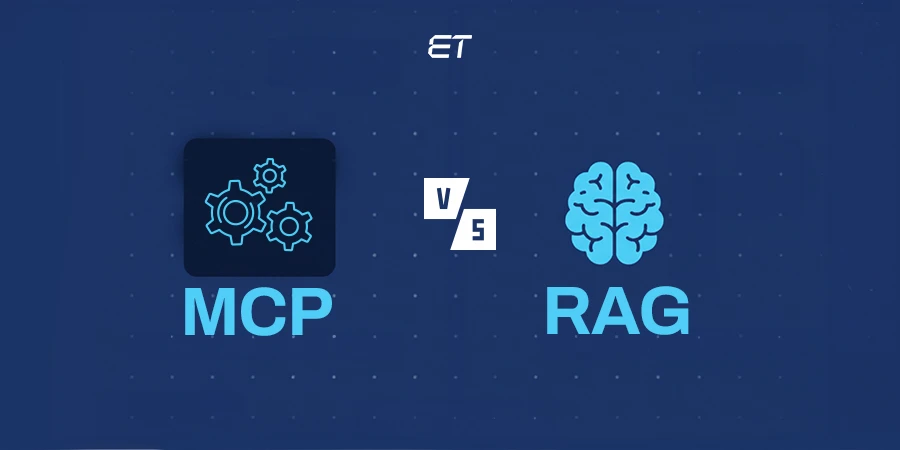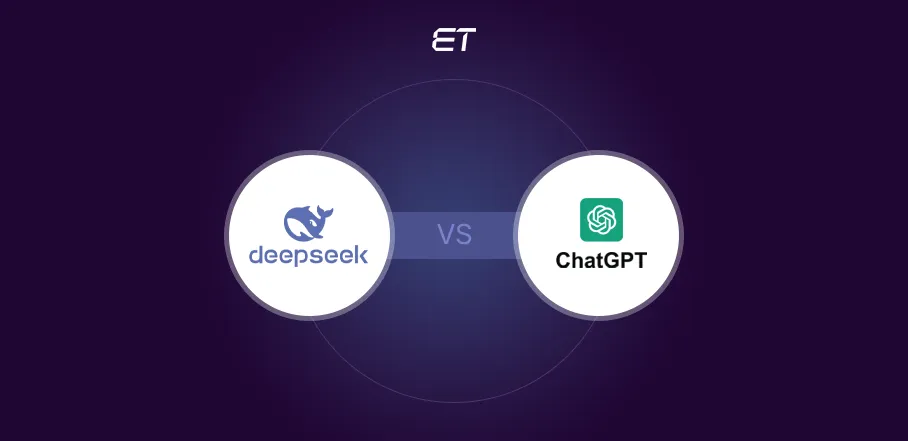
DeepSeek vs ChatGPT: Pros, Cons, and Key Differences Explained
- DeepSeek offers open-weight models ideal for custom deployments and technical tasks.
- ChatGPT provides a more polished, tool-rich experience with enterprise-grade security.
- DeepSeek is more cost-effective for high-volume or self-hosted use cases.
- ChatGPT includes advanced tools like browsing, file uploads, and voice/video modes.
Comparing DeepSeek vs ChatGPT is like picking between two titans, each with its own power moves. If ChatGPT is the benchmark for AI, DeepSeek is the new market disruptor.
DeepSeek excels in cost-efficient coding and open-source customization, while ChatGPT dominates in natural language reasoning and context retention.
So, if you’re on the hunt for the best AI solution, understanding their core differences is vital.
That’s why we’ve covered everything in detail in this ChatGPT vs DeepSeek comparison blog. You’ll know how they work, their benefits, drawbacks, and practical applications.
Time to test the two LLMs and find the perfect one for your business!
DeepSeek vs ChatGPT: Key Differences in One Snapshot
Check out the key differences between the two AI platforms before jumping into a detailed DeepSeek vs ChatGPT comparison.
| Feature | DeepSeek | ChatGPT |
| Model Type | Open-weight, partially open-source models. | Proprietary models (GPT-4o, GPT-4.5, GPT-3.5) |
| Language Support | Primarily English and Chinese. | Supports dozens of global languages. |
| Code Generation | Strong performance in benchmarks like HumanEval and LiveCodeBench. | Excellent for multi-layered coding and debugging via GPT-4o. |
| Mathematical Reasoning | High scores on MATH and AIME, performs well in complex multi-step problems. | Consistent performance with GPT-4o and GPT-4.5, especially in standardized test scenarios. |
| Tool Integration | Limited tool ecosystem; relies on developer implementation | Built-in tools: Python, File Uploads, Browsing, DALL·E, Code Interpreter, Voice Mode |
| Pricing | Token-based; starts at $0.014/1 M tokens; highly cost-efficient. | Subscription-based ($0–$200/month), with API pricing at $0.15–$2.50/1M tokens. |
| Customization | Supports fine-tuning and deployment on proprietary infrastructure. | Limited fine-tuning; offers custom GPTs for personalization. |
| Community and Ecosystem | Growing open-source developer community. | Large, active user base with robust support and frequent updates. |
What is DeepSeek?

DeepSeek is an open-source AI reasoning model developed by Liang Wenfeng, owner of a Chinese startup of the same name.
The tool was launched in July 2023 and has more than 38 million monthly active users globally. It handles mathematical problems, real-time decision-making, and logical reasoning tasks. DeepSeek’s latest model, DeepSeek‑R1‑0528, released on May 28, 2025, offers:
- Up to 10% boosts on AIME and logic benchmarks
- Better coding, math, inference
- JSON output, function‑calling, reduced hallucinations
- Same API usage with front‑end and schema improvements
Now, let’s look at some key features of DeepSeek AI.
| Feature | Description |
| Mixture-of-Experts (MoE) Architecture | The highly efficient architecture reduces computational load without compromising performance.
Ideal for scalable AI deployments. |
| Open-Weight |
Released under the MIT license, DeepSeek allows developers and researchers full access to its model weights. Model weights are learned parameters in an AI model that determine how it makes predictions. |
| High Code Competency | Trained extensively on code datasets, the AI platform performs exceptionally well in code generation, debugging, and syntax correction. It works across multiple programming languages like Python, Java, C++, and Go. |
| Multi-Language Support | Supports a wide range of natural languages, making it suitable for global applications in translation, content creation, and multilingual dialogue generation. |
| Chain-of-Thought Reasoning | Enables step-by-step logical processing, breaking down complex math problems, coding challenges, and multi-turn reasoning with better accuracy. |
Pros and Cons of DeepSeek
Here’s a brief rundown of the advantages and drawbacks of DeepSeek that you must keep in mind.
| Pros | Cons |
| Ideal for logical reasoning and coding tasks, offering excellent performance. | Primarily supports English and Chinese, with reduced effectiveness in other languages. |
| Supports function calling and structured JSON outputs for easier tool integration. | Requires significant computing power due to its MoE architecture, which may not suit small-scale users. |
| Uses reinforcement learning and logical routing to deliver structured and step-by-step responses. | Reports of exposed credentials, weak encryption, and susceptibility to prompt and SQL injection attacks. |
| MoE design allows powerful performance with lower training costs | May produce biased outputs and raise privacy issues around user data and potential government monitoring. |
| Actively maintained with frequent updates and strong GitHub community support. | Models hosted on Chinese servers may intentionally block or censor responses related to politically sensitive topics in China. |
What is ChatGPT?
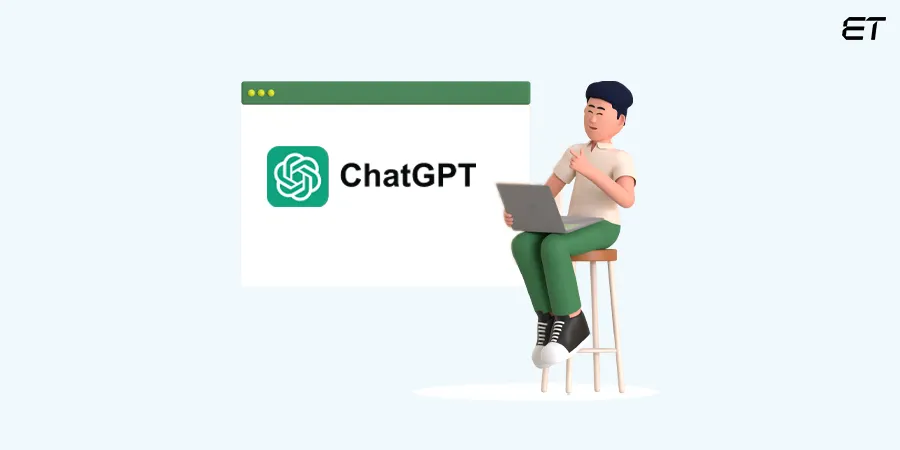
ChatGPT is a conversational AI developed by OpenAI, founded by Sam Altman in December 2015. Since its launch in November 2022, it’s been the most popular AI chatbot, with almost 800 million global users.
Unlike many LLMs, ChatGPT combines strong reasoning with a smooth conversational flow, making it accessible to casual users and professionals.
Its latest model, GPT-4o (released May 2024) handles text, audio, image, and video inputs with real-time responsiveness.
GPT-4o also offers improved emotional tone, faster inference, and a free-tier option, broadening its appeal even further.
Interested to know more? Here’s a table explaining the key features of ChatGPT.
| Feature | Description |
| Natural Conversation | Generates fluid, human-like responses with contextual memory and follow-up awareness. |
| Custom Instructions | Users can set preferences for tone, style, and focus, for personalized experiences or outputs. |
| Tool Integration | Integrates tools like Google Chrome for web browsing, Python for code interpretation, and DALL·E for generating images. |
| Advanced Reasoning | Excels in logical problem-solving, math, and code, which are crucial for complex tasks. |
| Cross-Device Sync | Chat history and settings sync across desktop, mobile, and web, creating a seamless user experience. |
Pros and Cons of ChatGPT
Understanding the pros and cons of ChatGPT is crucial before we begin comparing DeepSeek vs ChatGPT in the next section.
| Pros | Cons |
| Users can create tailored AI assistants with specific instructions, files, and APIs, without coding. | May lack awareness of events or updates beyond its training cut-off (currently April 2023 or May 2024 for GPT-4o). |
| Can understand and generate text in several languages. | May generate inaccurate or fictional information at times. |
| Handles millions of queries daily while maintaining low latency and high-quality responses, even under heavy demand. | Advanced tools and GPT-4-level performance are available only with the paid Plus plan (except for GPT-4 Basic). |
| Suitable for writing, coding, tutoring, research, and more. | It might use sensitive data in chats for model training unless settings are adjusted. For example, if an HR manager uploads employee salary data without disabling training, the model could unintentionally learn sensitive information. |
| Constant improvements ensure cutting-edge performance. | Needs human oversight in high-stakes contexts. For example, in medical environments, ChatGPT should assist but not replace professional judgment or expert validation. |
Seamlessly integrate ChatGPT into your apps and workflow.
DeepSeek vs ChatGPT: A Side-By-Side Comparison
DeepSeek and ChatGPT have unique features setting them apart in this competitive AI LLM market. However, as these platforms are constantly evolving, picking one can be confusing.
That’s why we’ll now compare DeepSeek vs ChatGPT using various factors to ease the process for you. Let’s start!
1. Code Generation Capabilities

We begin our comparison with DeepSeek vs. ChatGPT for coding.
DeepSeek offers excellent coding performance and strengthens your programming workflow for these reasons:
- It excels at handling backend logic, debugging, and complex math-heavy tasks.
- Great coding benchmark performances for HumanEval (89%) and LiveCodeBench (41%).
- The open-weight design allows teams to fine-tune the model using proprietary code, adapting it to their coding style, tools, and workflows. Code suggestions are more accurate and relevant.
- MoE architecture makes coding cost-efficient by using fewer resources per request, allowing fast and high-quality code generation.
The MoE architecture and open-weight nature make DeepSeek ideal for business leaders needing more control over their tech stack.
On the other hand, ChatGPT is also not far behind when offering convenient coding functionalities:
- Provides a highly interactive code writing, refactoring, and explaining process across multiple languages. GPT‑4.1 scores 54.6% on SWE-bench Verified.
- The conversational nature helps junior developers during cross-functional collaboration and rapid prototyping.
- Code explanations, API documentation, and step-by-step debugging support make ChatGPT ideal for rapid iterations.
- The integration with tools like Python, file uploads, and custom GPTs enables developers to enhance their coding workflows.
Bottom Line
Choose DeepSeek for open-source coding, cost-effective customization, local deployment, and better control.
Opt for ChatGPT for flexible, collaborative, and user-friendly coding, supporting the full development lifecycle.
2. Reasoning and Mathematical Accuracy

The next DeepSeek vs ChatGPT comparison factor is reasoning and mathematical accuracy, where both platforms perform well.
DeepSeek shows these characteristics with a focus on logic and structured problem-solving:
- For Math, it scores 79.8 for AIME 2024 and 97.3 for MATH-500. These scores make it suitable for solving complex equations and proofs.
- For reasoning, it scores 87.5 for AIME 2025 due to chain-of-thought reasoning and reinforcement learning.
- Ideal for breaking down multi-step problems methodically for structured domains like math and code.
- Makes it a reliable choice for engineers, data scientists, and developers working on precision-heavy tasks.
ChatGPT 4 and 4o are also highly capable in logical reasoning and math. As per the Artificial Analysis 2025 Quality Index report, here’s how it performs:
- 88.7% for the reasoning and knowledge (MMLU) test
- For MATH-500, GPT-4o scored 79% and 4o scored 74%
- For the HumanEval Benchmark, 4o scored 93%, and 4o mini scored 88%
Additionally, ChatGPT excels at explaining the steps of a problem, providing clear justifications, and offering multiple solutions.
Bottom Line
Choose DeepSeek for high-stakes, complicated, and logic-intensive tasks.
ChatGPT is more appropriate for strong reasoning, conversational explanations, collaboration, and guided decision-making.
3. Accessibility

When it comes to accessibility, DeepSeek vs ChatGPT models take very different approaches.
As DeepSeek is open-weight and available under the MIT license, developers get the following facilities:
- They can download and run it locally or on private servers, giving them complete command over deployments.
- The platform is highly accessible for teams that value customization, data privacy, or offline use.
- The architecture enables users to fine-tune, modify, and experiment with the model, tailoring it to their needs.
However, DeepSeek’s interface and documentation are more developer-focused, which can make onboarding harder for non-technical users.
On the contrary, ChatGPT is user-friendly and widely accessible.
- With apps available on the web, iOS, Android, and desktop, it supports seamless cross-device use.
- Multi-language support and integration with various tools make the platform accessible to tech and non-tech users.
But, as ChatGPT isn’t open-source, you can’t access its underlying code, architecture, or training data. This restricts the ability to customize or fine-tune the model for specific applications.
Bottom Line
Choose DeepSeek for open access, developer freedom, and experimentation.
However, if you need better ease of use, cross-platform compatibility, and multilingual support, go for ChatGPT.
4. Pricing Models

The AI tools you need to use daily must align with your software budget. That’s why we’ll compare the DeepSeek vs ChatGPT pricing models so you don’t end up overspending.
Here’s a table outlining the current DeepSeek pricing plans, based on model type and usage.
| Model | Input Price (per 1M tokens) | Output Price (per 1M tokens) | Features |
| DeepSeek-Chat (V3) | USD 0.014 – 0.07 | USD 0.28 – 1.10 | Cheapest tier, price varies based on cache hits and usage time |
| DeepSeek-Reasoner (R1) | USD 0.14 (cached) – 0.55 | USD 2.19 | Advanced reasoning model; higher output cost due to complexity |
| DeepSeek-Coder | USD 0.20 – 1.00 | USD 0.40 – 3.00 | Code-focused model; price varies based on version used |
| DeepSeek-RAG | Free (limited access) | Paid enterprise access | Retrieval-augmented generation; ideal for document-grounded tasks |
| Self-hosted Models | Free (MIT License) | N/A | Can be run locally with no API cost |
Now, let’s check out ChatGPT’s various models and plans.
| Plan | Enterprise | Free | Team | Plus | Pro |
| Price | Custom pricing (contact sales) | USD 0/month | USD 25/user/month (annual) or USD 30/user/month (monthly) | USD 20/month | USD 200/month |
| Model Access | GPT-4o, OpenAI o3, o4-mini, o4-mini-high, o1 pro mode | GPT-4.1 mini, limited GPT-4o, OpenAI o4-mini | GPT-4o, OpenAI o3-mini, o3-mini-high, o1 | GPT-4.5 (preview), GPT-4.1, OpenAI o3, o4-mini, o4-mini-high | All models including GPT-4o, OpenAI o1 pro mode |
| Message Limits | Higher than Team | Limited | Higher than Plus | Extended limits | Unlimited (subject to abuse guardrails) |
| Voice and Video | Includes advanced voice and video features | Limited voice mode | Includes advanced voice and video features | Standard and advanced voice mode with video and screen sharing | Unlimited advanced voice, higher limits for video, and screen sharing |
| File Uploads and Data Analysis | Included | Limited | Included | Extended access | Extended access |
| Deep Research Access | Included | Limited | Included | Included | Extended access |
Bottom Line
Choose ChatGPT Free or Plus for everyday use, learning, or content creation. Upgrade to Pro, Team, or Enterprise for unlimited access, advanced tools, and collaboration features.
However, pick DeepSeek for cost-efficient, open-source access and improved model deployment. It’s suitable for large-scale projects without high recurring subscription fees.
Curious about AI-assisted development expenses?
5. Security Features
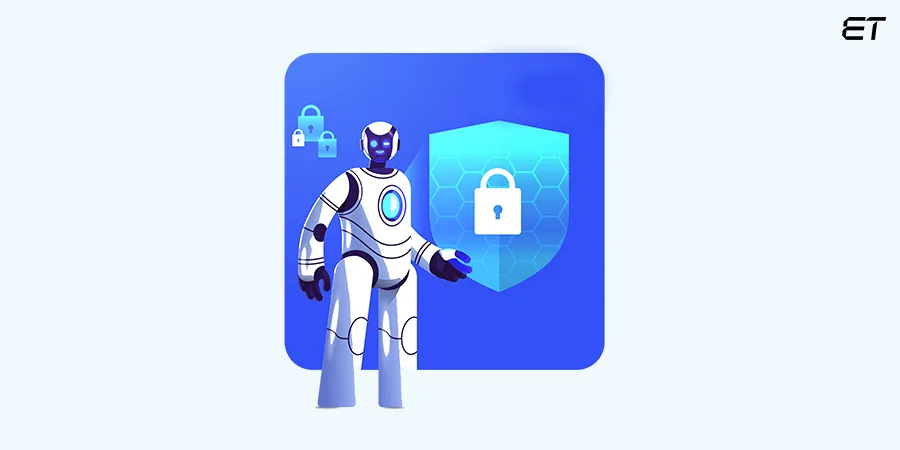
As you feed lots of sensitive internal business data into AI tools daily, evaluating their security features is essential. So, let’s assess the DeepSeek vs ChatGPT security aspects.
ChatGPT is hosted on OpenAI’s infrastructure, with enterprise-grade protection for its paid tiers. Other features include:
- The Enterprise plan includes SOC 2 compliance, SSO (Single Sign-On), data encryption, and admin-level controls.
- Enterprise, Team, or Pro plans don’t use prompts and data for model training.
Moreover, for organizations needing cloud security and compliance-ready AI infrastructure, ChatGPT provides transparent data handling policies.
On the other hand, DeepSeek also follows a transparency-first approach:
- Open-source and fully self-hosted for better data handling, access, and integration.
- Reinforcement learning-based self-correction enhances the model’s alignment with safety rules and ethical standards.
- Community-driven verification allows global developers to identify and address security risks.
The software is still in its early stages, so these security features will continue to improve.
Bottom Line
Choose ChatGPT if you need robust, out-of-the-box security, enterprise compliance, and cloud scalability.
However, if you prioritize control and custom app security, DeepSeek is a suitable choice.
Make sure to implement strong internal safeguards for secure deployment.
Stay Compliant. Stay Confident — with AI-Driven Defense
DeepSeek vs ChatGPT: Prompt Examples
After understanding the differences between the two AI tools, it’s time to see them work their magic!
We’ll give ChatGPT and DeepSeek the same prompt to work on and then analyze the results. Here’s the prompt:
“Draft a 3-year AI adoption roadmap for a mid-sized fintech firm focusing on efficiency, personalization, and risk mitigation, within 150 words.”
Here is ChatGPT’s response.

And here’s DeepSeek’s response.
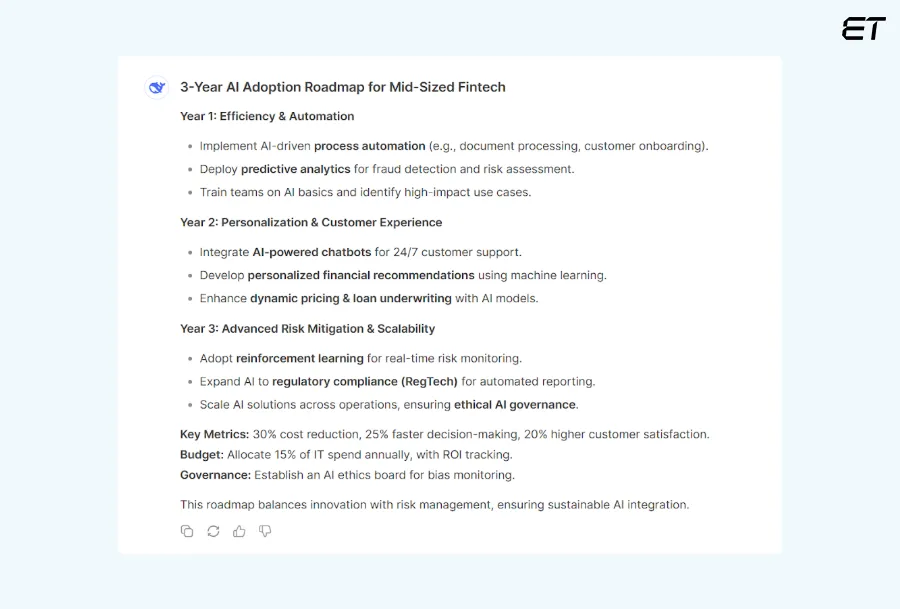
So, how do the responses differ?
- DeepSeek offers a formal, bulleted answer with bolded sections.
- ChatGPT generates a more narrative-style response with readable tips.
- DeepSeek includes key metrics, budget allocation, and AI governance steps.
- ChatGPT emphasizes strategic clarity and impact over operational details.
DeepSeek’s response is more execution-driven, technical, and suitable for internal planning or pitching. However, ChatGPT offers a response ideal for technical and non-technical teams, along with investor decks and strategic presentations.
Therefore, this DeepSeek vs ChatGPT comparison shows that both tools offer unique responses.
DeepSeek vs. ChatGPT: Which Is Better?
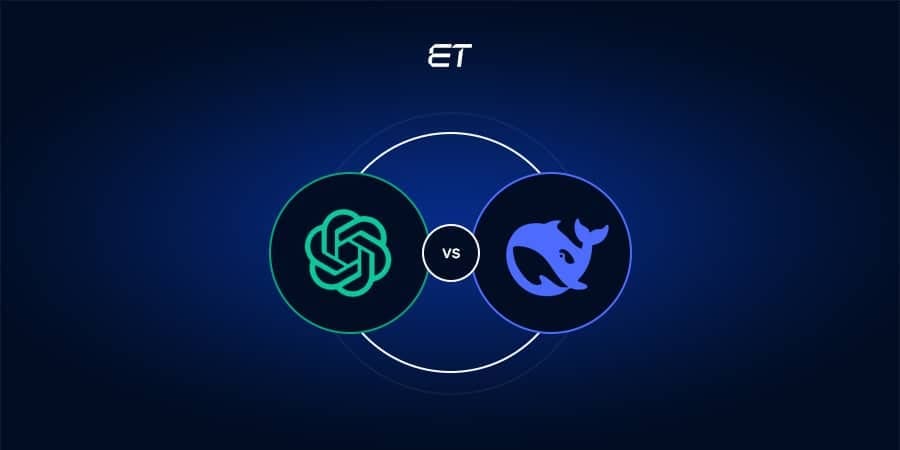
Considering a platform “better” based on DeepSeek vs ChatGPT performance, coding, or other factors is difficult. Each AI tool excels in specific fields.
For instance, DeepSeek is an excellent option for enterprises and developers:
- Ideal for organizations needing on-premise deployment, proprietary code fine-tuning, or full stack ownership.
- The open-weight access and a Mixture-of-Experts architecture make it highly customizable and resource-efficient.
Use Case: A healthcare tech company fine-tuning DeepSeek on private medical datasets for HIPAA-compliant, AI-assisted diagnostics and documentation.
However, ChatGPT is far more suitable for general users and small/medium-sized business teams:
- It offers a polished, multi-modal experience (text, images, audio, video) with features like web browsing and custom GPTs.
- Great for marketing, content creation, education, and customer support.
Use Case: A product manager using ChatGPT for user journey mapping, brainstorming, and data analysis.
Therefore, ChatGPT is best suited for everyday productivity, workflow optimization, and multi-modal tasks. DeepSeek is more suitable for AI engineers seeking control, customization, and infrastructure-level deployment.
Assess the DeepSeek vs ChatGPT parameters discussed earlier before finalizing one for your needs.
DeepSeek vs ChatGPT: Endnotes
Our deep dive into DeepSeek vs ChatGPT comes to an end.
But, what’s the final verdict? Which is the best AI tool for your business?
DeepSeek is suitable if you need more control, open-source flexibility, and cost-efficiency. Engineering teams can fine-tune it and integrate it into their tech stack. However, DeepSeek requires significant security oversight.
On the flip side, ChatGPT shines in accessibility, enterprise readiness, and ease of use. It offers robust security, powerful tool integrations, and a seamless user experience. Plus, it’s reliable and works across multiple devices easily.
So, weigh your options and seek AI development expertise before choosing a platform.
Enhancing AI workflows or building from the ground up?
Frequently Asked Questions
1. Is DeepSeek AI better than ChatGPT?
DeepSeek excels in technical reasoning, computation, and customization, while ChatGPT offers better usability, tools, and safety.
So, neither is ‘better’ when comparing DeepSeek vs. ChatGPT. It depends on your requirements.
2. How good is DeepSeek?
DeepSeek is capable in coding, reasoning, and math, especially for developers needing customization. In the DeepSeek vs ChatGPT debate, it’s ideal for teams valuing flexibility.
3. Which is better for building AI workflows – DeepSeek or ChatGPT?
In the DeepSeek vs ChatGPT comparison, DeepSeek is better for building custom AI workflows with complete control. ChatGPT excels in ease of use, integration, and excellent enterprise features.
Check out our recent video on how are we helping enterprises to enhance their productivity, reduce hallucinations using AI RAG model?




